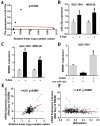Epigenetics mechanisms mediate the miR-125a/BRMS1 axis to regulate invasion and metastasis in gastric cancer
- PMID: 31571904
- PMCID: PMC6753057
- DOI: 10.2147/OTT.S210376
Epigenetics mechanisms mediate the miR-125a/BRMS1 axis to regulate invasion and metastasis in gastric cancer
Abstract
Purpose: Altered expression of breast cancer metastasis suppressor 1 (BRMS1), is a tumor suppressor, which is found in many types of cancers, including gastric cancer (GC), but the mechanism by which BRMS1 inhibits invasion and metastasis in GC is unknown. The aim of the study was to investigate the molecular mechanisms of miR-125a/BRMS1 in GC.
Materials and methods: The expression of BRMS1 and miR-125a were detected by quantitative real-time PCR (qRT-PCR) and analyzed by bioinformatics. BSP and MSP were used to detecte the methylation status of miR-125a and BRMS1 which was treated by 5-Aza or not. Western Blot and qRT-PCR were used to analyze the expression of BRMS1 and EZH2. Transwell was performed to explore the invasion and metastasis ability of GC cells. The nude mice were used for the tumor formation assay.
Results: BRMS1 may be regulated by copy number variation (CNV), methylation and miR-125a-5p. As one of the essential components of PRC2, EZH2 is an important regulatory factor resulting in the low expression of miR-125a. An epigenetic mechanism mediates the miR-125a/BRMS1 axis to inhibit the invasion and metastasis of GC cells. In vivo experiments, it is also showed that BRMS1 is involved in invasion and metastasis but not the proliferation in GC.
Conclusion: These studies shed light on the mechanism of BRMS1 inhibition of GC invasion and metastasis and the development of new drugs targeting the miR-125a/BRMS1 axis, which will be a promising therapeutic strategy for GC and other human cancers.
Keywords: EZH2; epigenetic; gastric cancer; invasion and metastasis; miR-125a/BRMS1 axis.
© 2019 Xiong et al.
Conflict of interest statement
The authors declare that they have no competing interests in this work.
Figures





Similar articles
-
MicroRNA-125a-5p inhibits invasion and metastasis of gastric cancer cells by targeting BRMS1 expression.Oncol Lett. 2018 Apr;15(4):5119-5130. doi: 10.3892/ol.2018.7983. Epub 2018 Feb 7. Oncol Lett. 2018. PMID: 29552146 Free PMC article.
-
Long Noncoding RNA HCG11 Acts as a Tumor Suppressor in Gastric Cancer by Regulating miR-942-5p/BRMS1 Axis.J Oncol. 2021 May 11;2021:9961189. doi: 10.1155/2021/9961189. eCollection 2021. J Oncol. 2021. PMID: 34054958 Free PMC article.
-
MiR-125a-5p inhibits the proliferation and invasion of breast cancer cells and induces apoptosis by targeting GAB2.Math Biosci Eng. 2019 Jul 29;16(6):6923-6933. doi: 10.3934/mbe.2019347. Math Biosci Eng. 2019. PMID: 31698596
-
microRNA-15b-5p encapsulated by M2 macrophage-derived extracellular vesicles promotes gastric cancer metastasis by targeting BRMS1 and suppressing DAPK1 transcription.J Exp Clin Cancer Res. 2022 Apr 22;41(1):152. doi: 10.1186/s13046-022-02356-8. J Exp Clin Cancer Res. 2022. Retraction in: J Exp Clin Cancer Res. 2022 Jun 29;41(1):213. doi: 10.1186/s13046-022-02426-x. PMID: 35449111 Free PMC article. Retracted.
-
Molecular mechanism and potential therapeutic targets of liver metastasis from gastric cancer.Front Oncol. 2022 Nov 9;12:1000807. doi: 10.3389/fonc.2022.1000807. eCollection 2022. Front Oncol. 2022. PMID: 36439439 Free PMC article. Review.
Cited by
-
EZH2 is involved in psoriasis progression by impairing miR-125a-5p inhibition of SFMBT1 and leading to inhibition of the TGFβ/SMAD pathway.Ther Adv Chronic Dis. 2021 Apr 15;12:2040622320987348. doi: 10.1177/2040622320987348. eCollection 2021. Ther Adv Chronic Dis. 2021. PMID: 33948156 Free PMC article.
-
Circular RNA circBCBM1 promotes breast cancer brain metastasis by modulating miR-125a/BRD4 axis.Int J Biol Sci. 2021 Jul 22;17(12):3104-3117. doi: 10.7150/ijbs.58916. eCollection 2021. Int J Biol Sci. 2021. PMID: 34421353 Free PMC article.
-
Multi-Omics Approach to Improved Diagnosis and Treatment of Atopic Dermatitis and Psoriasis.Int J Mol Sci. 2024 Jan 15;25(2):1042. doi: 10.3390/ijms25021042. Int J Mol Sci. 2024. PMID: 38256115 Free PMC article. Review.
-
The long and short non-coding RNAs modulating EZH2 signaling in cancer.J Hematol Oncol. 2022 Mar 2;15(1):18. doi: 10.1186/s13045-022-01235-1. J Hematol Oncol. 2022. PMID: 35236381 Free PMC article. Review.
-
DNMT1 promotes the proliferation and migration of gastric cancer cells by inducing microRNA-125a-5p methylation to promote SERPINE1 protein.World J Gastrointest Oncol. 2025 Mar 15;17(3):98703. doi: 10.4251/wjgo.v17.i3.98703. World J Gastrointest Oncol. 2025. PMID: 40092920 Free PMC article.
References
-
- Bray F, Ferlay J, Soerjomataram I, Siegel RL, Torre LA, Jemal A. Global cancer statistics 2018: GLOBOCAN estimates of incidence and mortality worldwide for 36 cancers in 185 countries. CA Cancer J Clin. 2018;68(6):394–424. - PubMed
-
- Allemani C, Matsuda T, Di Carlo V, et al. Global surveillance of trends in cancer survival 2000-14 (CONCORD-3): analysis of individual records for 37 513 025 patients diagnosed with one of 18 cancers from 322 population-based registries in 71 countries. Lancet. 2018;391(10125):1023–1075. doi:10.1016/S0140-6736(17)33326-3 - DOI - PMC - PubMed
-
- Seraj MJ, Samant RS, Verderame MF, Welch DR. Functional evidence for a novel human breast carcinoma metastasis suppressor, BRMS1, encoded at chromosome 11q13. Cancer Res. 2000;60(11):2764–2769. - PubMed
LinkOut - more resources
Full Text Sources
Research Materials
Miscellaneous

